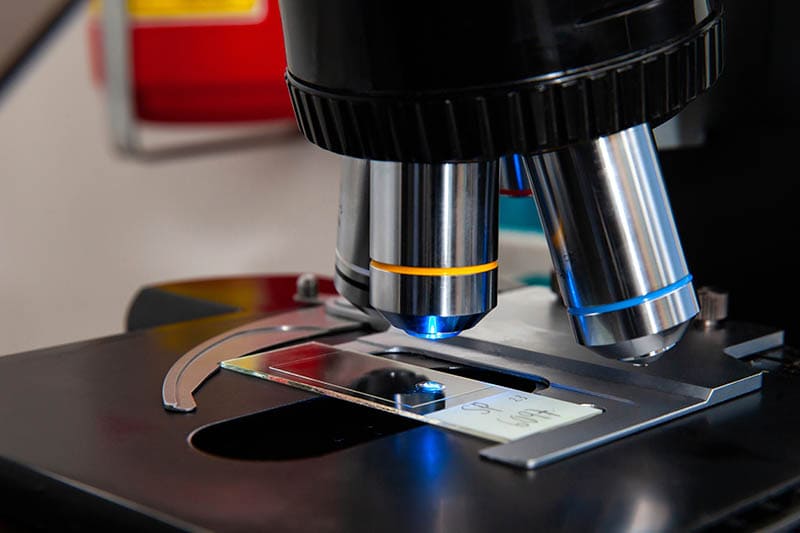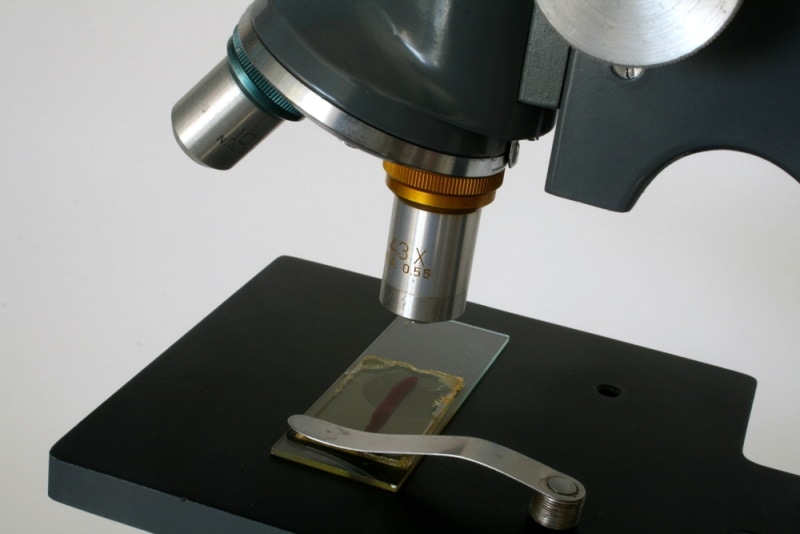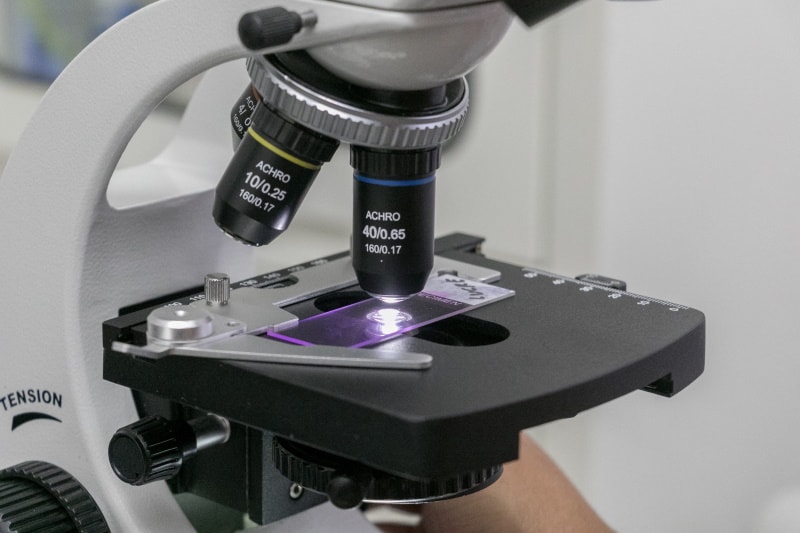What Is a Stage on a Microscope? The Interesting Answer!
Last Updated on

Microscopes are made of various components, each with a specific function. However, while some of them are easily recognizable and most people know what they are, there are microscope elements that are not too well known. That doesn’t mean they’re unimportant, but sometimes, it’s easy to underestimate certain microscope elements as others don’t mention them enough.
One of those elements is a stage, which is very important for your microscope to function correctly. A stage on a microscope is the platform where you place the slide. That’s why we wanted to educate people who use or have an interest in microscopes about this component.

What is Its Function?
A stage on a microscope is a platform where you place the slide to observe your subject. It has clips on the side that hold the specimen in place and allow movement from side to side and front to back to obtain the focus of the object you’re observing.
Of course, the type of the stage and its function will depend on the type of microscope you own. Cheaper microscopes typically don’t have all the stage movement options like some more expensive models.
Microscope stages can differ in terms of lighting, features, and travel. The maximum X distance represents the most significant distance a stage can travel in an X direction. In contrast, the maximum Y distance represents the most significant distance a stage can travel in a Y direction.
When it comes to lighting styles of microscope stages, there are two different styles:
- Transmitted: It originates from inside the stage directly or from underneath the stage
- Reflected: It comes from the microscope directly or from another light source above the microscope stage
There’s a microscope stage for every field of work that uses microscopes, so it’s all about your needs and wishes to make your observation successful. As for the stage features, some microscope stages have the hardware to measure the specimen you’re observing. Others allow you to have circular motions, tilt the specimen at multiple angles, etc.
What Are the Different Types of Microscope Stages?

- Simple microscope stage: The stage clips are loaded with springs and hold the slide in place. If you need to adjust the slide, you need to do it manually by pushing the slide in the direction that’s convenient for you. That’s why these stages are not desirable for high magnification. This stage typically has a stopping or a locking mechanism to lock your specimen and prevent it from moving. They also include a rack stop that prevents the stage from getting too close to the objective lens as it can damage it.
- Mechanical microscope stage: The slide on this stage is controlled by a system that’s directly mounted to the stage. You can move the attached knobs, making the slide go in your desired direction. This stage allows precise movements as you can move the specimen slightly by moving the knobs without the need to do it manually.
- Circular microscope stage: This stage allows even more precision and flexibility when observing the sample because it rotates 360°. These stages typically include stage clips but also have a mechanical attachment that makes this stage a combination of the circular and mechanical stages.
Specialized microscope stage
Some microscopes have specifically designated purposes, and they can have stages with auxiliary equipment, measuring systems, and other features that make them distinctive from other microscopes. Below are some common types of specialized microscope stages.
- Inverted microscope stage: The design of these microscopes is different from a regular upright microscope. They have their objectives below the stage and an array of configured illumination systems for observing the specimen.
- Tissue microscopes: The stage has a huge opening that allows the observer to scan large culture flasks and observe a population of cells. They also have a condenser mounted beneath the stage.
- Epi-illumination microscopy: These microscopes have stages with a substage condenser that allows you to precede the objectives and goals.
- Precision measurement microscope stage: These stages only exist on measurement microscopes, so they’re frequently used for quality testing. These stages typically obtain a rotating plate that can move 360° to allow you to take measurements from any point and side of the specimen.
- Universal microscope stage: This microscope stage allows you to tilt a specimen at multiple angles to measure the birefringent visual structure. People commonly use it when examining rock samples, crystals, and liquids.
- Micromanipulator microscope stage: These microscope stages have two hydraulic control micromanipulators configured within the stage. They can accommodate several avenues and angles when observing the subject. People use microscopes with this stage type to manipulate samples with precise movements to the submicron scale. You can see their usage in biology, engineering, optics, and various experiments.
- Stereo microscope stage: These stages are transparent instead of having a hole inside, and light from the bulb shines through the transparent section of the plate. These typically don’t have mechanical stage features as you can handle the specimen movement by hand.
- Electron microscope stage: This is a nonmagnetic microscope stage that’s used in vacuum conditions and environments.
Why Is It Important?

Using the microscope stage is essential as it will allow you to have a better overview of the specimen and make microscope handling easier. When using a stage, you have better control of the slide, and it’s easier to focus on your subject. It also allows systematic scanning of the slide to see the whole specimen.
Microscope stages also have higher magnification because you can move the specimen at different angles and sides.
Advantages and Disadvantages of Microscope Stages
- Accurate and precise positioning of the slide
- Provides smooth movement on the slide
- No need to apply pressure to the stage when moving the slide
- Better control when moving the slide
Without the stage, the whole microscope handling process would be more challenging. While this might not bother amateur or recreational microscope users, that could be tricky for people who use microscopes for serious projects.
There’s an array of different microscope stages, so depending on your work and the specimen you’re observing, you can use microscopes with different stages to achieve desired results. You can refer to the types of microscope stages above if you’re unsure about which stage would work for your next project or experiment.
Frequently Asked Questions (FAQs)
Where Is the Stage in a Microscope?
The stage is typically located under the microscope and either lowered or raised for observation. It holds the specimen in place and allows different movements that help you observe your subject better. Depending on your type of microscope, the stage might have different functions, as they frequently have various add-ons that help you with your experiments.

Summing Up
The stage on a microscope is an extremely important component; without it, you wouldn’t be able to observe your desired specimen properly. Remember to select a microscope with a suitable stage for your projects, as that will save you a lot of time and effort while observing your specimen.
Featured Image Credit: Anamaria Mejia, Shutterstock
About the Author Robert Sparks
Robert’s obsession with all things optical started early in life, when his optician father would bring home prototypes for Robert to play with. Nowadays, Robert is dedicated to helping others find the right optics for their needs. His hobbies include astronomy, astrophysics, and model building. Originally from Newark, NJ, he resides in Santa Fe, New Mexico, where the nighttime skies are filled with glittering stars.
Related Articles:
What Is the Best Binocular Magnification for Hunting? Optical Features Explained
How to Clean a Refractor Telescope: Step-by-Step Guide
How to Clean a Telescope Eyepiece: Step-by-Step Guide
How to Clean a Rifle Scope: 8 Expert Tips
Monocular vs Telescope: Differences Explained (With Pictures)
What Is a Monocular Used For? 8 Common Functions
How to Clean a Telescope Mirror: 8 Expert Tips
Brightfield vs Phase Contrast Microscopy: The Differences Explained
